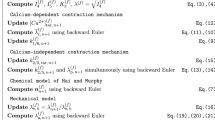Abstract
This paper presents a first approximation to the simulation of vascular smooth muscle cell following an agent-based simulation approach. This simulation incorporates mathematical models that describe the behaviour of these cells, which are used by the agents in order to emulate vascular contraction. A first tool, implemented in Netlogo, is provided to allow the performance of the proposed simulation.
Access this chapter
Tax calculation will be finalised at checkout
Purchases are for personal use only
Similar content being viewed by others
References
Behrendt, D., Ganz, P.: Endothelial function: from vascular biology to clinical applications. Am. J. Cardiol. 90(10, Supplement 3), L40–L48 (2002)
Lüscher, T.F., Richard, V., Tschudi, M., Yang, Z., Boulanger, C.: Endothelial control of vascular tone in large and small coronary arteries. J. Am. Coll. Cardiol. 15(3), 519–527 (1990)
Galley, H.F., Webster, N.R.: Physiology of the endothelium. BJA: Br. J. Anaesth. 93(1), 105 (2004)
Lacolley, P., Regnault, V., Nicoletti, A., Li, Z., Michel, J.-B.: The vascular smooth muscle cell in arterial pathology: a cell that can take on multiple roles. Cardiovasc. Res. 95(2), 194–204 (2012)
Majesky, M.W., Dong, X.R., Hoglund, V., Mahoney, W.M., Daum, G.: The adventitia. Arterioscler. Thromb. Vasc. Biol. 31(7), 1530–1539 (2011)
Thorne, B.C., Hayenga, H.N., Humphrey, J.D., Peirce, S.M.: Toward a multi-scale computational model of arterial adaptation in hypertension: verification of a multi-cell agent-based model. Front. Physiol. 2, 1–12 (2011)
Wang, Z., Butner, J.D., Kerketta, R., Cristini, V., Deisboeck, T.S.: Simulating cancer growth with multiscale agent-based modeling. Semin. Cancer Biol. 30, 70–78 (2015). Elsevier
Dada, J.O., Mendes, P.: Multi-scale modelling and simulation in systems biology. Integr. Biol. 3(2), 86–96 (2011)
Qu, Z., Garfinkel, A., Weiss, J.N., Nivala, M.: Multi-scale modeling in biology: how to bridge the gaps between scales? Prog. Biophys. Mol. Biol. 107(1), 21–31 (2011)
Wessel, M.D., Jurs, P.C., Tolan, J.W., Muskal, S.M.: Prediction of human intestinal absorption of drug compounds from molecular structure. J. Chem. Inf. Comput. Sci. 38(4), 726–735 (1998)
Stenberg, P., Luthman, K., Artursson, P.: Virtual screening of intestinal drug permeability. J. Control. Release 65(1), 231–243 (2000)
Gao, H., Lajiness, M.S., Van Drie, J.: Enhancement of binary QSAR analysis by a GA-based variable selection method. J. Mol. Graph. Model. 20(4), 259–268 (2002)
Eyer, C.L.: Goodman & gilman’s: the pharmacological basis of therapeutics. Am. J. Pharm. Educ. 66(1), 95 (2002)
Shen, M., LeTiran, A., Xiao, Y., Golbraikh, A., Kohn, H., Tropsha, A.: Quantitative structure-activity relationship analysis of functionalized amino acid anticonvulsant agents using k nearest neighbor and simulated annealing PLS methods. J. Med. Chem. 45(13), 2811–2823 (2002)
Omicini, A., Ricci, A., Viroli, M.: Artifacts in the A & A meta-model for multi-agent systems. Auton. Agents Multi-Agent Syst. 17(3), 432–456 (2008)
Murtada, S.I., Kroon, M., Holzapfel, G.A.: A calcium-driven mechanochemical model for prediction of force generation in smooth muscle. Biomech. Model. Mechanobiol. 9(6), 749–762 (2010)
Yang, Jin, Clark, John W., Bryan, Robert M., Robertson, Claudia S.: The myogenic response in isolated rat cerebrovascular arteries: vessel model. Med. Eng. Phys. 25(8), 711–717 (2003)
Author information
Authors and Affiliations
Corresponding authors
Editor information
Editors and Affiliations
Rights and permissions
Copyright information
© 2017 Springer International Publishing AG
About this paper
Cite this paper
Rincon, J.A., Sol, GO., Julian, V., Carrascosa, C. (2017). Vascular Contraction Model Based on Multi-agent Systems. In: Fdez-Riverola, F., Mohamad, M., Rocha, M., De Paz, J., Pinto, T. (eds) 11th International Conference on Practical Applications of Computational Biology & Bioinformatics. PACBB 2017. Advances in Intelligent Systems and Computing, vol 616. Springer, Cham. https://doi.org/10.1007/978-3-319-60816-7_25
Download citation
DOI: https://doi.org/10.1007/978-3-319-60816-7_25
Published:
Publisher Name: Springer, Cham
Print ISBN: 978-3-319-60815-0
Online ISBN: 978-3-319-60816-7
eBook Packages: EngineeringEngineering (R0)




